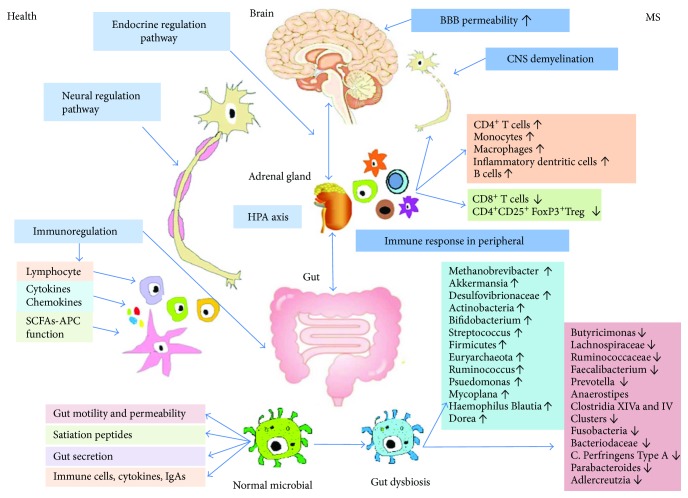Figure 1.
The role of the gut microbiota in health and MS. The gut microbiota can affect the body's nervous system function in numerous ways, including the neural regulating pathway, the endocrine pathway-HPA axis, and the immunoregulating pathway (via lymphocyte, cytokines, chemokines, and antigens presenting effect of SCFAs). The normal microbiome has many functions: (1) maintenance of the motility and permeability of the gut; (2) synthesis and secretion of essential vitamins, such as vitamin B12, folate, vitamin K, nicotinic acid, biotin, riboflavin, pyridoxine, panthotenic acid, and thiamine; (3) maintenance of intestinal epithelial functions, such as absorption and secretion; and (4) local stimulation of the development of innate and adaptive immune systems via GALT secreting immune cells, cytokines, and IgAs. When the gut microbiota is in dysbiosis, several diseases may develop, such as MS. The pathology of MS includes increased BBB permeability, destruction of the myelin layer in the CNS, and inflammatory cell infiltration of perivascular tissues. The immunological changes of MS in the periphery are characterized by an increase in pro-inflammatory effector such as CD4+ T cells, monocytes, macrophages, inflammatory dendritic cells, and B cells and a decrease in CD8+ T cells and CD4+ CD25+ FoxP3+ Treg cells [84, 87–90]. Patients with MS can exhibit gut microbial dysbiosis, with increases in Methanobrevibacter Akkermansia [128], Desulfovibrionaceae [132], Actinobacteria, Bifidobacterium, Streptococcus [137], Firmicutes, Euryarchaeota [133], Ruminococcus [138], Pseudomonas, Mycoplana, Haemophilus, Blautia, and Dorea [140] and decreases in Butyricimonas [128], Lachnospiraceae, Ruminococcaceae [132], Faecalibacterium, Prevotella, Anaerostipes, Clostridia XIVa and IV Clusters [137], Fusobacteria [133], Bacteroidaceae [138], C. perfringens type A [139], Parabacteroides, and Adlercreutzia [140]. BBB: blood-brain barrier; CNS: central nervous system; HPA axis: hypothalamic-pituitary-adrenal axis; SCFA: short chain fatty acids; APC: antigen presenting cell; GLAT: gut-associated lymphoid tissue; FoxP3: forkhead box 3; Treg: regulatory T cells.

